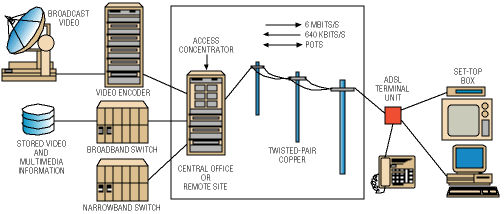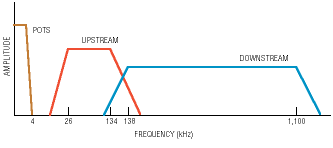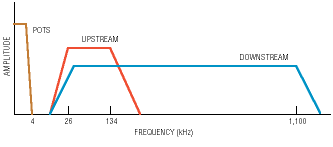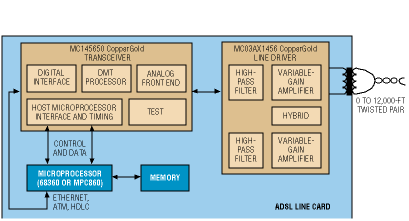Selecting an ADSL transceiver:
ANSI standard offers
two levels of
modem performance
T1.413 Category II defines an advanced feature set for higher
data throughput and backward compatibility with Category I
BY RICK HALL
Motorola Semiconductor
Austin, TX
Asymmetric digital subscriber line (ADSL) is a modem technology for
a new generation of high-speed modems. ADSL uses an advanced signal modulation
technique called discrete multitone (DMT) to transmit data over normal
copper telephone wires at rates 200 times faster than current V.34 modems.
With a data rate of 6 Mbits/s, ADSL (see Fig. 1 ) offers users blazing Internet browsing speeds while simultaneously preserving Plain Old Telephone Service (POTS). Consequently, ADSL provides a quick, cost-effective way for network service providers to offer multi-megabit services, such as distance learning or telecommuting, using the 650 million telephone lines already in place throughout the world.

Fig. 1. ADSL modem technology delivers high-speed Internet access over existing telephone lines,
while simultaneously preserving Plain Old Telephone Service (POTS).
Intensive standards development, spearheaded by the T1E1.4 working group of the American National Standards Institute (ANSI), led to the publication of the T1.413 ADSL interface standard in 1995. This document details the standard functions of an ADSL modem and enables the design of interoperable, multivendor products.
More than 50 equipment and semiconductor vendors are now developing T1.413-compliant ADSL products. Other standards bodies such as the European Telecommunications Standards Institute and the International Telecommunication Union point to T1.413 as a reference for their ADSL standards.
For modem designers, a careful review of T1.413 is essential when evaluating ADSL chipsets. In particular, understanding the different categories of the T1.413 standard is crucial in determining how an ADSL modem will actually perform in the field.
Two levels of performance
While specifying a basic set of features common to any ADSL terminal unit (ATU) modem, T1.413 calls out additional functions that enhance performance, especially over longer and noisier lines. The basic ATU is called a Category I modem, while the enhanced ATU is called a Category II modem.
Category II adds two key features that can increase data throughput significantly: trellis coding and echo cancellation. A third option, called power boost–a brute force method of increasing performance by cranking up the transmit signal strength–is no longer under consideration because of concerns about excessive crosstalk with other wires in the same binder group.
To ensure compatibility between Category I and II modems, various device options and setup information are transmitted at startup. This procedure allows the device at each end of the wire to be aware of the other's capabilities and to adjust itself accordingly.
A Category II modem falls back to basic Category I operation when necessary, similar to the way different V-series modems fall back to lower data rates (28.8 to 14.4 kbits/s, for example). However, when acting in this mode, Category II features are lost since both modems must be Category II-compliant in order to take advantage of the enhanced features.
Category II benefits
The first feature that aids Category II performance is trellis-coded modulation. Trellis coding was first introduced in the early 1980s as a novel way for modems to overcome the effects of noise found on satellite links and telephone lines.
In trellis coding, bit-error-rate (BER) performance is improved by mapping groups of data bits to specially designed symbol sequences that can then be decoded more accurately in the presence of noise at the receiver. By storing the incoming sequences of symbols at the receiver, clever decoding schemes such as the Viterbi algorithm can be employed to make better decisions about the actual transmitted data. Trellis coding can boost performance by 4 dB, an improvement that can transform a marginal BER of 1 error in 1,000 bits into a much more palatable BER of 1 error in 100,000 bits.
The second performance-boosting feature is echo cancellation, a bandwidth-sharing scheme commonly used in high-speed dial-up modems. To understand the benefit of echo canceling, it's necessary to first understand how ADSL uses bandwidth.
ADSL employs full-duplex data transmission of up to 6 Mbits/s in the downstream direction to the end user and up to 640 kbits/s in the upstream direction back to the network. In Category I, the downstream and upstream signals are able to coexist on the same line via frequency division multiplexing (FDM) as shown in Fig. 2 . The downstream signal is isolated in the 138 to 1,100-kHz frequency band while the upstream signal uses the 26 to 134-kHz band. The lower 4-kHz band is reserved for existing POTS voice transmissions.

Fig. 2. Frequency division multiplexing allows upstream and downstream
data to exist on the same line.
To fully maximize the available bandwidth, Category II employs an echo cancellation scheme so that the downstream and upstream signals can overlap in frequency (see Fig. 3 ). The chief benefit is that the downstream signal now has more bandwidth to work with, theoretically boosting data throughput by about 10%.

Fig. 3. Echo cancellation enables overlapping of upstream and downstream
data, reusing the high-quality, low-frequency spectrum for increased throughput.
Since the downstream/upstream signals cannot be separated at the receiver using normal bandpass filtering, an echo cancellation circuit must be used to subtract out the unwanted transmit signal as well as its return echoes (caused by impedance mismatches down the line). Echo cancellation is clearly a more complex operation than FDM, but one easily implemented with today's VLSI technology.
The extra bandwidth used by the downstream signal is in a very desirable location since signal distortion caused by the telephone line decreases dramatically at lower frequencies. In the DMT modulation scheme used in ADSL, data is transmitted over 256 different subcarriers, each with its own frequency band and bitloading (that is, the number of bits transmitted on a subcarrier during each symbol time).
Typically, the lower-frequency subcarriers can be assigned higher bitloads, since these signals encounter less distortion, which means cleaner signals and higher data throughput. For example, a subcarrier near 1 MHz might have a bitload of only 6 bits/Hz, while a lower-frequency subcarrier near 100 kHz could have twice that amount. Since echo cancellation switches on extra downstream subcarriers in the lower 26 to 138-kHz band, the resulting bitloading gains can improve data throughput well in excess of the expected 10%.
Extending coverage
Both trellis coding and echo cancellation are common techniques used to squeeze the maximum amount of data from a transmission link, while preserving an acceptable BER (typically 1 error in 10 million bits). However, increasing data throughput is not the only reason for their usage. Often the goal of improving performance is to allow a modem to operate over longer distances, whether for a microwave relay station or a deep space probe.
Operating reach is a formidable challenge to the widespread deployment of ADSL, since the telephone network presents such a staggering array of different wire gauges, cable types, and loop lengths. The system is replete with nasty impairments such as attenuation, phase distortion, crosstalk, and bridged taps (unterminated wire pairs hanging off the main line that are particularly onerous to high-frequency signals like ADSL). As a result, the telephone line network is a particularly demanding environment for high-speed data transmission, particularly over long distances.
With its arsenal of enhanced features, a Category II modem can more effectively combat line impairment gremlins to help ensure that the maximum data rate of 6 Mbits/s can be realized over the target range of 0 to 12,000 ft. To reach beyond this range, the data rate can be reduced, which improves the ability of the modem's signal to travel further down the line.
Category II modems can decrease the data rate to 1.5 Mbits/s or less so as to operate over longer distances–up to 18,000 ft–while ensuring optimized performance. Since it is estimated that 80% of telephone lines are less than this distance, the vast majority of homes can now be reached by ADSL service.
Implementing ADSL
One approach to ADSL modem design is provided by Motorola's CopperGold chipset, which consists of the MC145650 ADSL transceiver and the MC03AX1456CO/RT line driver. The two devices integrate all the signal-processing and analog line interface circuitry necessary for developing a T1.413-compliant ADSL modem (see Fig. 4 ). In addition, the transceiver features a DSP-based echo canceller and a trellis encoder/ Viterbi decoder to allow either Category I or Category II operation in the end system.

Fig. 4. The CopperGold ADSL chipset from Motorola is designed to offer Categories I and II performance.
The line driver comes in two versions: one optimized for the central office (CO) side of an ADSL connection and the other for the remote terminal (RT) at the end user's site. Separate devices are desirable due to the asymmetric nature of ADSL.
The CO version has the tougher job of transmitting the downstream signal with frequencies up to 1,100 kHz, while the RT version transmits the upstream signal at frequencies only up to 134 kHz. Included in both devices is an on-chip electronic hybrid that aids echo cancellation by attenuating the transmit signal to the receiver by about 10 dB.
Advertisement





